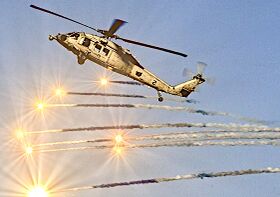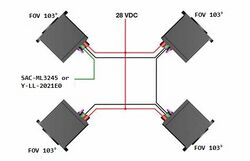LIDACS ECM Suite
| LIDACS | |
|---|---|
 Inyurstan UH-60YS2 fires 2F20 flares | |
| Type | Multimode Counter-Measures Suite |
| Place of origin | |
| Service history | |
| Used by | |
| Production history | |
| Designer | Navayelle Systems |
The LIDACS (Légero - Informatíques Detêtíon por Aérocraft d'Combatte e Secouras), or "Light Detection Informatics for Combat & Surveillance Aircraft", is a counter-measures software system, or "suite", of passive electronic counter-measures used on aircraft. LIDACS is designed to fill the task of Threat Acquisition, Alert & Discrimination (TAAD), processing information from multiple sensors and making a rapid threat ID faster than a human pilot can, and then thus alerting said human pilot to the nature of the threat.
Concept
LIDACS functions as a "calculator", taking data from existing warning-based avionics and providing the pilot (or copilot/WSO) with a likely estimate of missile guidance. Aspects such as missile trajectory, RWR returns, and response to previously employed countermeasures are quickly processed and factored into a series of equations as parameters. The unique combination of parameters is then taken to determine the guidance mechanism of the oncoming warhead; for example an extremely simplified calculation:
[Parameter: Active Chase = 1] + [Parameter: Radar Warning = 0] + [Parameter: Laser Targeting = 0] = Conclusion: IR Guided Missile
[Parameter: Active Chase = 1] + [Parameter: Radar Warning = 1] + [Parameter: Laser Targeting = 0] = Conclusion: Radar Guided Missile
Most models also automatically deploy flares, chafe or decoys if a missile enters within a critical distance of the aircraft.
Shortcomings
The most common shortcoming of the LIDACS system is cases of "multiple guidance" where either the same warhead uses dual-guidance modes or multiple missiles are launched. Missiles which utilize a separate terminal guidance or multimode guidance can throw off the system by causing it to erroneously calculate any missile with a radar lock as a radar-guided missile. Likewise, cases where an enemy aircraft (or two SAMs right next to each other) fire an infrared and a radar-guided missile at the same relative time can also cause the system to calculate them both as radar-guided.
In the Lolloh-Ruol Wars, poorly-trained Lollohian pilots would often fire short-range infrared guided missiles at distances well beyond their effective ranges. While this was an overall horrid strategy, such firings would often spoof the system and cause Inyurstan pilots abort firing position or waste flares & chaff against missiles that were no threat. Later LIDACS-II and LIDACS-III were coded to ignore missiles which demonstrated a significant drop in speed and changes to trajectory to counter this situation. However, the primary shortcoming - that being the inability to actually identify the model and specifications of the oncoming missile - remains.
Modular Flares & Chaff
Flare Packs
- 2F20: A universal pack of medium-sized high-heat magnesium-based flares.
- 2F25: A universal pack of medium-sized, high-heat magnesium-based flares with parachutes attached for slower descent
- 2F25: A universal pack of medium-sized, high-heat magnesium-based flares with parachutes attached for slower descent
- 3F30: A cocktail of both medium-sized and large-sized
Alkyl Aluminum-based pyrophoric flare
- 9F15: The current first-pick for low-flying attack aircraft and CAS missions, the 9F15 includes a "cocktail" of both high-heat MTV-based flares,(with and without parachutes), AA-based pyrophoric flares, and PP/HO spectrally balanced flares (with and without parachutes). The 9F15 can also semi-vertically (up to 65o) eject flares rearward.
- 9F15ER:: A 9F15 module modified for delayed ejection where the flares are ejected at a slower pace rather than all at once to increase time in the air & distance traveled while shrouded by flares.
9F30: A similar pack to the 9F15 but adapted for higher-altitude missions. Includes a "cocktail" of both high-heat MTV-based flares,(with and without parachutes), AA-based pyrophoric flares, and a mix of both instant-ignition and delayed ignition PP/HO spectrally balanced flares (with and without parachutes). Because the AA-based pyrophoric flares require additional oxygen, they are physically larger and thus are in less quantity than the 9F15 despite constituting an equal proportion of the dispenser.
- 9F30ER: Delayed ejection modification of 9F30.
Chaff
LIDACS-I
LIDACS-II
LIDACS-II was born from lessons learned in air-to-air combat in the Lolloh-Ruol Wars, specifically from the experiences of AC-88 pilots.
Due to the improved state of built-in RWR antennae found in the AC-88E Taipan, the LIDACS-II offers both improved TAAD and better long-range threat discrimination. By detecting specific radar threats at a distance, the system improves accuracy of its calculation via "weighting" the likilihood of powerful radar alerts and long-range launchers in favor of radar-guided missile threats. Threat discrimination is improved to relative radar bandwidth (i.e. low-frequency vs high-frequency vs VHF/UHF), which helps discriminate between likely sources of active radar guided missiles versus passive or semi-active radar guided missiles.
Combined IRST and MLD nodes allow the system to "counter-predict" the trajectory of an oncoming missile, which alert the pilot to the likelihood of tail-chase versus proportional-pursuit missiles and effect which flare nodes are activated in priority.
LIDACS-III
The LIDACS-III is currently the most advanced system in the counter-measures suite.
A major feature of the LIDACS-III is its ability to sync and share data with the Sevât-M Counter-Emissions System. By offloading radar frequency discrimination to a separate computing system, it allows LIDACS-III to continue diverting processing power towards providing full spectrum awareness. The information provided by the Sevât-M is then back-loaded into threat identification by the LIDACS system, and then either the pilot is alerted or proper counter-measures are deployed. Likewise, this also upgrades emissions sensitivity & identification to - with calibration and training - decipher between different radar bandwidths. Furthermore, identification of an approximate "emissions profile" can be used to better employ DRFM Jamming.
Both AC/A-20 Crotalea and AC/A-92 Night Adder aircraft employ active infrared counter-measures. LIDACS-III detection and identification of IR-guided missiles and their relative flight trajectories (tail-chase vs proportional pursuit) allows these systems to better misdirect the warhead sensors.
LIDACS-III also leads its predecessors in "counter-offensive capabilities", boasting the fastest sync time between launch detection and targeting software, allowing the pilot to quickly task ordinance to the source of the threat. This process is aided by the fighter's radar information and IRST/EOST being used in the LIDACS-III data analysis.
LIDACS-IIIv2
A proposed improvement module to deal with off-boresight air-to-air missiles. (???)
Controversy
Incorporation Estavez-Kilo (IEK) was the target of a misinformation lawsuit by Navayelle Systems after claiming that the Amérifighter EF-20 acted as a "miniature ELINT" aircraft to foreign potential buyers. Navayelle, who designed the LIDACS & Sevat-M systems, clarified that the abilities of the EF-20 are purely defensive in nature and not for intelligence gathering. IEK and Navayelle likely settled out-of-court, but what is publicly known is that all branding of the EF-20 (AC/A-20 in Inyurstan service) as a "miniature ELINT" was dropped.
LIDACS-LAH
Host Platforms
Current:
Under Testing:

